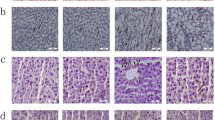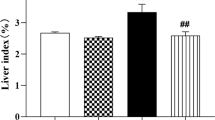Abstract
Purpose
The current study was carried out to assess the effects of chronic intermittent hypoxia (CIH) on the kidney, the intervention roles of adiponectin (Ad), and the associated mechanisms.
Methods
Sixty Wistar rats were randomly divided into four groups: the normal control (NC), normal control plus Ad supplement (NC + Ad), CIH, and CIH plus Ad supplement (CIH + Ad) groups. The rats in both CIH and CIH + Ad groups were submitted to a CIH environment for 4 months, while the rats in NC and NC + Ad groups were housed with the normal air for 4 months. In addition, the rats in NC + Ad and CIH + Ad groups were treated with an intravenous injection of Ad at a dosage of 10 μg per injection, twice a week, for four successive months.
Results
The production level of reactive oxygen species (ROS) and the protein levels of endoplasmic reticulum (ER) stress, as well as the cell apoptosis level in kidney, were all higher in the CIH group than in the NC and NC + Ad groups (all p < 0.05). However, the ROS production, the protein of ER stress, and cell apoptosis levels in kidney were all lower in the CIH + Ad group than those in the CIH group (all p < 0.05).
Conclusion
Ad could protect against CIH-induced renal cell apoptosis through inhibiting ROS-related ER stress.






Similar content being viewed by others
References
Inamoto S, Yoshioka T, Yamashita C, Miyamura M, Mori T, et al. (2010) Pitavastatin reduces oxidative stress and attenuates intermittent hypoxia-induced left ventricular remodeling in lean mice. Hypertens Res 33:579–586
Zhou W, Li S, Wan N, Zhang Z, Guo R, et al. (2012) Effects of various degrees of oxidative stress induced by intermittent hypoxia in rat myocardial tissues. Respirology 17:821–829
Hernandez-Guerra M, de Ganzo ZA, Gonzalez-Mendez Y, Salido E, Abreu P, et al. (2013) Chronic intermittent hypoxia aggravates intrahepatic endothelial dysfunction in cirrhotic rats. Hepatology 57:1564–1574
Chou YT, Lee PH, Yang CT, Lin CL, Veasey S, et al. (2011) Obstructive sleep apnea: a stand-alone risk factor for chronic kidney disease. Nephrol Dial Transplant 26:2244–2250
Sim JJ, Rasgon SA, Kujubu DA, Kumar VA, Liu IL, et al. (2009) Sleep apnea in early and advanced chronic kidney disease: Kaiser Permanente Southern California cohort. Chest 135:710–716
Hetz C (2012) The unfolded protein response: controlling cell fate decisions under ER stress and beyond. Nat Rev Mol Cell Biol 13:89–102
Grimm S (2012) The ER-mitochondria interface: the social network of cell death. Biochim Biophys Acta 1823:327–334
Bravo R, Gutierrez T, Paredes F, Gatica D, Rodriguez AE, et al. (2012) Endoplasmic reticulum: ER stress regulates mitochondrial bioenergetics. Int J Biochem Cell Biol 44:16–20
Kawakami T, Inagi R, Takano H, Sato S, Ingelfinger JR, et al. (2009) Endoplasmic reticulum stress induces autophagy in renal proximal tubular cells. Nephrol Dial Transplant 24:2665–2672
Mahfoudh-Boussaid A, Zaouali MA, Hadj-Ayed K, Miled AH, Saidane-Mosbahi D, et al. (2012) Ischemic preconditioning reduces endoplasmic reticulum stress and upregulates hypoxia inducible factor-1alpha in ischemic kidney: the role of nitric oxide. J Biomed Sci 19:7
Cammisotto PG, Londono I, Gingras D, et al. (2008) Control of glycogen synthase through ADIPOR1-AMPK pathway in renal distal tubules of normal and diabetic rats. Am J Physiol Renal Physiol 294:F881–F889
Sharma K, Ramachandrarao S, Qiu G, et al. (2008) Adiponectin regulates albuminuria and podocyte function in mice. J Clin Invest 118:1645–1656
Ding W, Zhang X, Huang H, Ding N, Zhang S, et al. (2014) Adiponectin protects rat myocardium against chronic intermittent hypoxia-induced injury via inhibition of endoplasmic reticulum stress. PLoS one 9:e94545
Fleischmann G, Fillafer G, Matterer H, Skrabal F, Kotanko P (2010) Prevalence of chronic kidney disease in patients with suspected sleep apnoea. Nephrol Dial Transplant 25:181–186
Tabas I, Ron D (2011) Integrating the mechanisms of apoptosis induced by endoplasmic reticulum stress. Nat Cell Biol 13:184–190
Jing G, Wang JJ, Zhang SX (2012) ER stress and apoptosis: a new mechanism for retinal cell death. Exp Diabetes Res 2012:589589
Shore GC, Papa FR, Oakes SA (2011) Signaling cell death from the endoplasmic reticulum stress response. Curr Opin Cell Biol 23:143–149
Rubio C, Pincus D, Korennykh A, Schuck S, El-Samad H, et al. (2011) Homeostatic adaptation to endoplasmic reticulum stress depends on Ire1 kinase activity. J Cell Biol 193:171–184
Rasheva VI, Domingos PM (2009) Cellular responses to endoplasmic reticulum stress and apoptosis. Apoptosis 14:996–1007
Schroder M (2008) Endoplasmic reticulum stress responses. Cell Mol Life Sci 65:862–894
Marciniak SJ, Yun CY, Oyadomari S, Novoa I, Zhang Y, et al. (2004) CHOP induces death by promoting protein synthesis and oxidation in the stressed endoplasmic reticulum. Genes Dev 18:3066–3077
Nakagawa T, Zhu H, Morishima N, Li E, Xu J, et al. (2000) Caspase-12 mediates endoplasmic-reticulum-specific apoptosis and cytotoxicity by amyloid-beta. Nature 403:98–103
Chen L, Einbinder E, Zhang Q, Hasday J, Balke CW, et al. (2005) Oxidative stress and left ventricular function with chronic intermittent hypoxia in rats. Am J Respir Crit Care Med 172:915–920
Wang Y, Zhang SX, Gozal D (2010) Reactive oxygen species and the brain in sleep apnea. Respir Physiol Neurobiol 174:307–316
Ding W, Yang L, Zhang M, Gu Y (2012) Reactive oxygen species-mediated endoplasmic reticulum stress contributes to aldosterone-induced apoptosis in tubular epithelial cells. Biochem Biophys Res Commun 418:451–456
Liu ZW, Zhu HT, Chen KL, Dong X, Wei J, et al. (2013) Protein kinase RNA-like endoplasmic reticulum kinase (PERK) signaling pathway plays a major role in reactive oxygen species (ROS)-mediated endoplasmic reticulum stress-induced apoptosis in diabetic cardiomyopathy. Cardiovasc Diabetol 12:158
Acknowledgments
We are grateful to PIs of the department of cardiology lab.
Author information
Authors and Affiliations
Corresponding authors
Ethics declarations
Conflict of interest
The authors declare that they have no conflict of interest.
Funding
The study was supported by the National Natural Science Foundation of China (81370184 and 81500071). The sponsor had no role in the design or conduct of this research.
Ethical approval
All applicable international, national, and institutional guidelines for the care and use of animals were followed. The Animal Ethics Committee of Nanjing Medical University approved this study.
Additional information
Wenxiao Ding contributed equally to Yuanpei Cai
Rights and permissions
About this article
Cite this article
Ding, W., Cai, Y., Wang, W. et al. Adiponectin protects the kidney against chronic intermittent hypoxia-induced injury through inhibiting endoplasmic reticulum stress. Sleep Breath 20, 1069–1074 (2016). https://doi.org/10.1007/s11325-016-1321-4
Received:
Revised:
Accepted:
Published:
Issue Date:
DOI: https://doi.org/10.1007/s11325-016-1321-4




